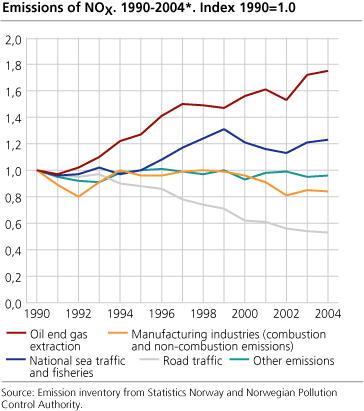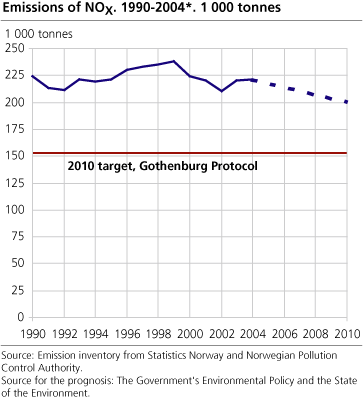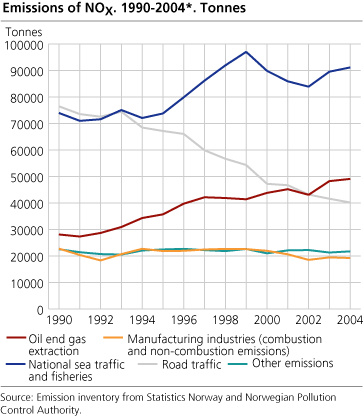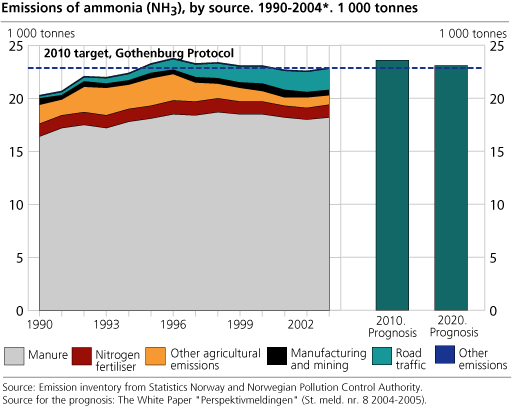Content
Published:
This is an archived release.
NOX emissions stable, but reductions needed
In 2004, emissions of nitrogen oxides were at about the same level as the year before. However, the emissions must be reduced by 30 per cent by 2010 if Norway is to meet its commitments under the Gothenburg Protocol.
Reduced emissions from oil heating and road traffic were more than offset by increased emissions from gas production on the continental shelf and the production of iron, steel and ferroalloys.
These are some of the findings in new preliminary figures from Statistics Norway and the Norwegian Pollution Control Authority.
The Gothenburg Protocol enters into force on 17 May this year. According to the protocol, Norway is committed to ensuring that by 2010 emissions do not exceed the limits set for (SO2), nitrogen oxides (NOX), ammonia (NH3) and volatile organic compounds (NMVOC). The emission ceilings have been negotiated based on critical loads for acid rain and ground-level ozone.
In 2004, emissions of nitrogen oxides (NOX) increased moderately to about 221 000 tonnes. To meet its commitment according to the Gothenburg Protocol, which is 156 000 tonnes, Norway's emissions must be reduced by 30 per cent by 2010.
Increase in some types of emissions in 2004
In 2004, emissions from oil and gas production on the continental shelf and from the production of iron, steel and ferroalloys increased. The increasing emissions from the oil and gas activity were caused by increased electricity production on the continental shelf. Gas production is more energy demanding than oil production, so despite reduced oil production in 2004, a 7 per cent increase in gas production led to a rise in NOX emissions. The preliminary figures also indicate increased emissions from domestic shipping.
... decrease in others
In 2004, the use of fuel oils decreased, resulting in a reduction of NOX emissions from stationary combustion in manufacturing industries and other sectors. Emissions from road traffic were also reduced, in spite of increased road traffic. The main reasons for reduced road traffic emissions were the use of catalytic converters and lower emissions per kilometre in newer cars.
Domestic shipping still most important emission source
Domestic shipping (including fishing vessels) accounted for 33 per cent of Norwegian NOx emissions in 1990, while in 2003 this had risen to 40 per cent. An increase from 12 to 22 per cent was also observed for the oil and gas industry during this period. Road traffic emissions, on the other hand, decreased from 34 per cent in 1990 to 19 per cent in 2003. This is partly due to the requirements placed on NOX emissions from vehicles. These reductions were achieved despite the substantial increase in traffic in the period.
Emissions from international sea and air traffic are not included in the official statistics.
| Emission ceiling 2010 according to the Gothenburg Protocol. Status 2004 and prognosis 2010. Tonnes (per cent) |
| Component | Emissions 1990 | Emissions 2004 | Emission ceiling 2010 | Prognosis 2010 | Necessary reduction 2003-2010 | ||||||||||||||||||||||||||||||||||
|---|---|---|---|---|---|---|---|---|---|---|---|---|---|---|---|---|---|---|---|---|---|---|---|---|---|---|---|---|---|---|---|---|---|---|---|---|---|---|---|
| Nitrogen Oxides (NOX) | 223 878 | 221 407 | 156 000 | 200 800 | 65 000 tonnes (30 per cent) | ||||||||||||||||||||||||||||||||||
| NMVOC | 294 529 | 266 208 | 195 000 | 168 800 | 71 000 tonnes (27 per cent) | ||||||||||||||||||||||||||||||||||
| Ammonia (NH3) | 20 375 | 22 513 | 23 000 | 23 600 | Emission ceiling reached at the moment | ||||||||||||||||||||||||||||||||||
|
Source:
Emission inventory from Statistics Norway and Norwegian Pollution Control Authority.
Source for the prognosis: The White Paper "Perspektivmeldingen" (St. meld. nr. 8 2004-2005). |
Only minor changes in ammonia emissions
In 2004, 22 500 tonnes of ammonia were emitted. This is 500 tonnes below the obligation of the Gothenburg Protocol, and 300 tonnes lower than in 2003.
See also
Emissions of greenhouse gases still increasing
Greenhouse gas emissions in Oslo up 9 per cent
National accounts and the environment
See also State of the Environment Norway
More emission figures in StatBank .
Tables:
The statistics is published with Emissions to air.
Contact
-
Statistics Norway's Information Centre
E-mail: informasjon@ssb.no
tel.: (+47) 21 09 46 42




